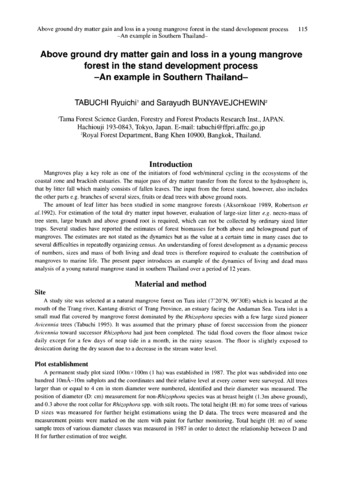Philippine mangroves: status, threats and sustainable development
- Global styles
- MLA
- Vancouver
- Elsevier - Harvard
- APA
- Help

View/
Date
2004Author
Page views
53,274AGROVOC keyword
Taxonomic term
Metadata
Show full item record
Share
Abstract
The status of the Philippine mangroves is examined, the functions of mangrove areas are highlighted, the threats to mangrove resources are identified, and the prospects for sustainable use are discussed. The Philippines harbour 39 species of true mangroves belonging to the following genera: Acanthus, Camptostemon, Lumnitzera, Excoecaria, Pemphis, Xylocarpus, Aegiceras, Osbornia, Nypa, Aegialitis, Bruguiera, Ceriops, Kandelia, Rhizophora, Scyphiphora, and Sonneratia. The fauna is equally diverse. Apart from fish and shrimp, other animals collected from mangroves are crabs and lobsters, bivalve and gastropod molluscs, and other invertebrates. Mangrove services include coastal protection, erosion control, sediment stabilization, flood regulation, nutrient supply and regeneration, waste treatment, and wildlife habitats. Mangroves could be valuated at around 10,000 US$/ha/year. As elsewhere, it can be expected that the net present value is highest if the mangrove cover is maintained. The decline of mangroves from about 500,000 ha in 1918 to only 120,500 ha in 1994 was caused by overexploitation by coastal dwellers and to conversion to settlements, agriculture, aquaculture, salt pans, and industry. The remaining mangroves should be conserved. It is recommended to establish the following zones: (1) protected forest; (2) productive forest; (3) reforestation areas; and (4) conversion areas.
Suggested Citation
Primavera, J. H. (2004). Philippine mangroves: status, threats and sustainable development. In M. Vannucci (Ed.), Mangrove Management and Conservation: Present and Future (pp. 192–207). Tokyo, Japan: United Nations University Press.
Type
Book chapterCollections
- Books and Book Chapters [123]
Related items
Showing items related by title, author, creator and subject.
-
Field guide to Philippine mangroves
Awareness of mangrove importance, particularly for coastal protection, has grown among the general public over the past several years. In turn, this has led to numerous planting initiatives by various groups. However, most ... -
Series: JIRCAS Working Report;No. 35
Above ground dry matter gain and loss in a young mangrove forest in the stand development process: An example in southern Thailand
Tabuchi, Ryuichi; Bunyavejchewin, Sarayudh (Japan International Center for Agricultural Sciences, 2003)This paper introduces an example of the dynamics of living and dead mass analysis of a young natural mangrove stand in southern Thailand over a period of 12 years. -
Mangroves and community aquaculture
Unknown author (Aquaculture Department, Southeast Asian Fisheries Development Center, 2000)Describes the efforts of AQD to raise mudcrab in pens in mangrove areas in Palawan and Aklan with the participation of local communities.






